As a cat owner, it is your duty to provide your furry housemate with his basic necessities — tasty nutritious meals, a cozy warm bed, and of course, an ideal spot for him to poop and piddle. Believe me, you don’t want your cat doing his business on your expensive hardwood floor. To ensure this, you need a good cat litter to get the work done.
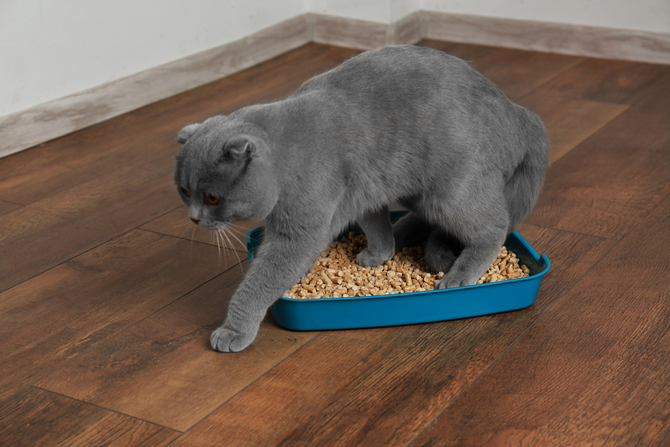
However, even choosing a cat litter can be a baffling task. Pet stores have a mind-boggling display of cat box fillers made with varying materials. There are those that are made of pine, recycled paper, silica gel crystals, wheat hulls, walnut shells, and so forth. They also come in different sizes and scents. Nevertheless, there is one type of cat litter that has soared a phenomenal growth over the recent years.
Introducing, the clumping cat litter.
What is a Clumping Cat Litter?
The clumping cat litter was actually an accidental discovery back in the early 1980s. Biochemist Dr. Thomas Nelson studied sodium bentonite clay and discovered how it formed clumps when exposed to moisture. He tried the said clay in his cat’s litter box and observed how it prevented urine from breaking down. So instead of emptying out an entire box, he merely chucked out dried clumps.
How Does a Clumping Cat Litter Work?
A clumping cat litter is designed for easy removal of waste without the need to unload the entire tray. Its primary ingredient, sodium bentonite, enables the litter to form a compact mass when exposed to liquid or wet substances.
As soon as the litter is clumped together, you can scoop it out of the tray and leave the unsoiled litter in its place. Then simply replenish the tray with an equivalent amount of fresh litter. Being able to do all of this means your cat’s litter box stays clean and dry for much longer.
Nonetheless, that doesn’t mean that you won’t have to wash your cat’s litter tray ever again. A clumping litter only reduces the frequency of the task. A litter tray containing this type of litter still requires to be emptied and thoroughly cleaned at least once a month.
Moreover, some clumping variants use quartz silica. There are also others that use diatomaceous earth. There are also products that use alternative fibers. Regardless, you can rest assured that these modern cat litters are all-natural products.
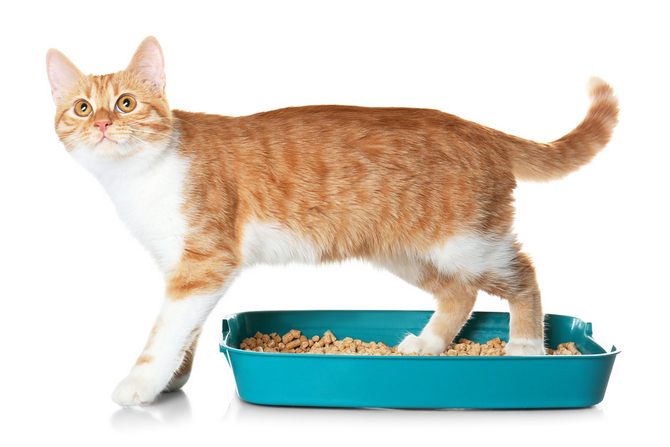
Pros of Using a Clumping Cat Litter
Let’s see if a clumping cat litter is worth the hype by taking a closer look at its advantages.
Absorbs more waste
According to www.vetinfo.com, a clumping cat litter made with sodium bentonite clay features superior liquid absorption. It can expand up to 15 times its size when in contact with urine. Compared to other types of cat litters, a clumping cat litter is more efficient in absorbing pungent cat poop, says the American Chemical Society.
Suitable for a large cat or for a multi-pet household
If you have a big cuddly feline with a correspondingly large bladder such as a Maine Coon, a clumping cat litter would be enough to deal with his high-volume output. The same goes for a cat with special needs. A diabetic cat, for instance, drinks a lot of water and expectedly pees a lot. Due to its high absorbency, a clumping litter would also serve as the ideal litter for a family with multiple cats.
Helps maintain a virtually odor-free home
A cat’s excrement (particularly, its poop) emits an invisible cloud of stench that could linger for hours. It is so offensive, that you can barely mask it with chemical-infused air fresheners. But with a properly managed clumping litter, you can maintain the air quality of your home even if you have multiple cats.
Bentonite clay alone features incredible odor-binding properties. It even does a great job at fighting bacteria such as E. Coli, MRSA, and Salmonella. What’s more, a majority of clumping litters today contain activated carbon and baking soda to further enhance its effects.
Easy to maintain
Clumping cat litters immediately form extremely hard lumps as soon as they come into contact with your pet’s waste. So, it is hardly possible for urine to seep into the plastic bottom of the tray. Otherwise, you’ll be having a hard time getting rid of the ammonia smell. All you have to do is perform a quick scoop to make the litter tray spick and span. No scrubbing needed.
Economical
Since you won’t have to discard the entire contents of a litter tray on a weekly basis, a clumping litter is economical in the long run. It also saves you a lot of time and effort. A jug of clumping cat litter can last for 30 days for each cat.
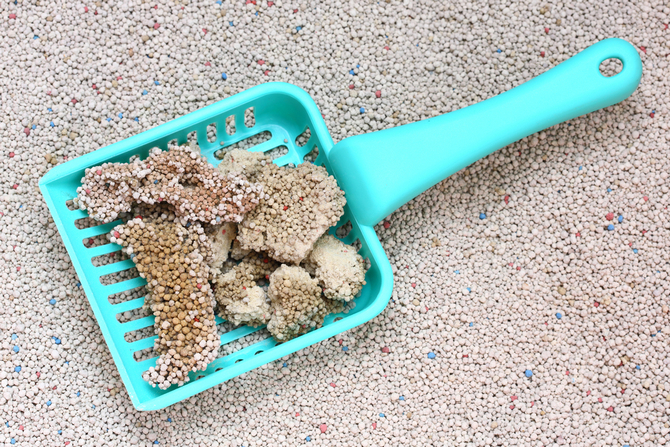
Non-Clumping vs Clumping Cat Litter: Which One to Choose?
Shortly after World War II, Businessman Ed Lowe revolutionized cat litter. He pioneered the non-clumping cat litter we know today. A non-clumping litter is actually just a clumping litter minus the clumping effect. Calcium bentonite is the major component of the non-clumping litter, which is also a type of clay that features fantastic absorption.
For over half a century, the non-clumping litter was dearly prized among cat owners for its high absorbency. However, that was when ash, dirt, and sand were the only alternatives. Its popularity decreased since the clumping cat litter was introduced. Roughly 69% of commercial cat litters are clumping variants.
Many cat owners are still torn between the traditional non-clumping litter and its upgraded version, the clumping litter. There are benefits and drawbacks to both variants. Due to this, it is best to dig into their differences and compare each other’s strengths and weaknesses. By doing so, you’ll know what you’re expecting and save yourself from potential disappointments.
Composition
Non-clumping cat litters are made primarily of calcium bentonite while the clumping variants contain sodium bentonite. The major dissimilarity between the two bentonite clays is that contact with moisture allows sodium bentonite to form a clump. Likewise, sodium bentonite binds the moisture within the clump. Though typically made of clay, non-clumping litters also use plant-based alternatives such as alfalfa, beet pulp, corn cobs, oat hulls, pine, wheat, wood shavings, and the list goes on.
Clumping cat litters, on the other hand, have fewer selections. Diatomaceous earth, quartz, and other alternatives don’t clump as effectively as sodium bentonite. So, if you want a cat litter that strongly clumps, opt for conventional clay.
Odor control
The clumping variant does an exemplary job at locking in foul odors for long periods. By being able to get rid of the odor source as quickly as possible, you also prevent ammonia buildup.
Meanwhile, the odor-fighting capabilities of non-clumping variants are mediocre. Usually, they use fragrances to mask the smell. Unfortunately, ammonia builds up fast. Waiting for a non-clumping litter to reach its saturation point only maximizes the odor. But if you are willing to empty out your cat’s litter box every day, then perhaps that won’t be a problem.
Dust
Both variants produce a significant amount of dust due to the usage of clay. A non-clumping cat litter produces less dust compared to its competitor. Nonetheless, there are formulations for clumping cat litters that are designed to minimize the amount of dust.
Maintenance
You only deal with non-clumping litters when you need to dump out the contents of an entire litter box. A majority of non-clumping cat litters reach its saturation point within a week (provided that you use a standard size litter box). However, the urine may start to pool at the base of the box as the litter becomes saturated.
Ammonia buildup is very likely in non-clumping litters since it takes a little while to empty it out. Many cat owners who have used non-clumping litter complained that it takes a lot of effort to remove soiled non-clumping litter, especially when pet odors have permeated into the plastic.
Meanwhile, a litter box with clumping cat litter would require less cleaning. The life of your cat’s litter box is longer with a clumping litter since you aren’t expected to empty out its contents at a weekly basis. However, daily monitoring is imperative. It is ideal to scoop up clumped urine and poop daily, even if it doesn’t smell. Also, make sure to maintain a constant depth of cat litter. Finally, wash and disinfect the litter box thoroughly every four weeks.
Cost
A majority of non-clumping cat litters are cheaper in price compared to clumping cat litters. That is why there are still many cat owners who prefer non-clumping litters to clumping litters.
However, the economical use of clumping litter makes it a moot point among cat owners whether or not the latter ranks first in the competition of low expenses. If you use a non-clumping litter but decided to manually empty out a litter box every other day to prevent odors, then you would end up shelling out a lot of cash.
The obvious benefit of a clumping litter is its ability to form hard clumps of cat pee and poop. Thus, it does a great job at preventing odors and the accumulation of urine. Then again, it all boils down to your cat’s preference. Cats can be extremely picky about their litter boxes. Sometimes you’ll have to try out several types of clumping litters to find which one works best for your whiskery friend. Therefore, give your feline companion a choice.
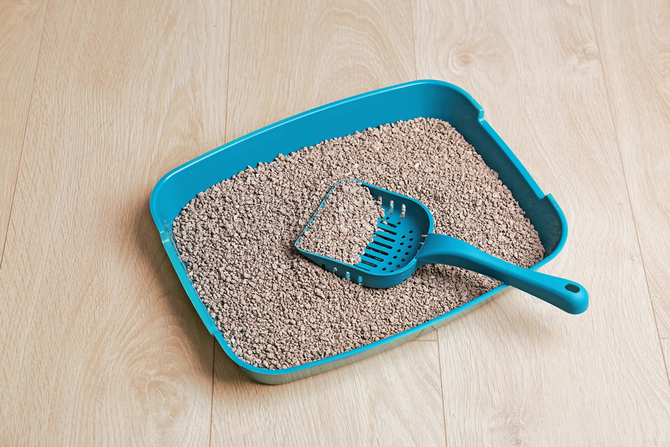
Clumping Cat Litter: Factors to Consider
The following are key factors that you should take into account before making a purchase.
1. Price
Oftentimes, the biggest deciding factor is a product’s price. After all, it makes no sense buying a cat litter that doesn’t fit your budget. So, we make sure our choices give you more bang out of your buck. The products’ prices still vary depending on its quality and of course, its brand.
Here’s a tip: once you’ve established which brand to buy, buy it in larger quantities. You’ll find that a product packaged in a bigger bag is actually the best way to save money.
2. Scents
Cats usually prefer unscented litters. So, it is best to refrain from scented cat litters all in all, particularly floral and citrus fragrances that they hate the most. Make your cat’s potty feel and smell as natural as possible. After all, cats don’t do their business on flowers.
3. Odor control additives
Clumping cat litters are notable for their odor control. Nonetheless, some brands offer certain mechanisms for superior odor control. Odor control refers to the ability to lock in foul odors instead of simply masking it. Look for a product with activated carbon, baking soda, cedar chips, pine or a combination of these are eco-friendly deodorizers.
4. Clumping rate
Clumping cat litters don’t all clump as fast. There are brands that are designed to clump as fast as a few seconds while others may take a minute. A cat litter with a faster clumping effect ensures foul odors are quickly locked in to prevent it from dispersing around your house.
In addition, a product’s clump may also vary in size. Some brands may form large clumps while others form smaller clumps. Small clumps are less wasteful and they lock in odors more quickly. However, make sure your shovel won’t allow it to slip through the gaps when you scoop them out.
5. Low tracking
Cats, in general, prefer a clumping litter among other types. This is mainly due to the feel of the litter under their paws. Clumping litters have a granular texture reminiscent of sand, which makes cats love to step and dig into it. Regardless, the litter should stay in the box where it belongs. An ideal litter should not be redeposited outside of your cat’s litter box. Otherwise, your floors will get messy.
10 Best Clumping Cat Litters
To save you from the hassles of further guesswork, we searched high and low to present to you 10 of the best clumping cat litters. To determine which product is best suited for your feline companion, try three or more varieties and conduct a preference test. We are confident with our choices as we ranked them with careful considerations.
1. Dr. Elsey’s Precious Cat Ultra
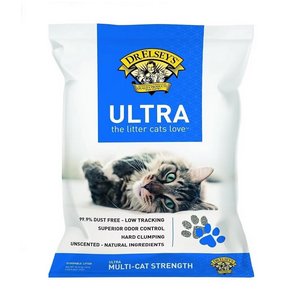
Dr. Elsey’s Precious Cat Ultra boasts of a unique formula consisting of medium-grain clay plus the heavy non-tracking granules of the Precious Cat Classic. The result is a superior clumping effect as it prevents air and moisture from seeping into the clumps. The clumps will remain hard and dry even if it takes a little while for you to scoop them up. Likewise, this premium litter features a hypoallergenic formula, making it perfect for sensitive cats. It is also 99% dust-free.
- suitable for sifting and mechanical litter boxes
- forms very hard clumps that won’t break down
- 99.9% dust-free, hypoallergenic formula
- ideal for households with multiple cats
2. World’s Best Multiple-Cat Formula
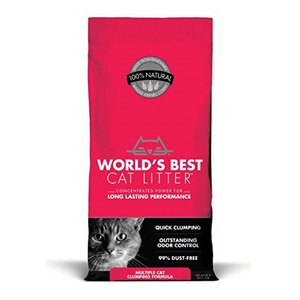
One of the best things we like about this clumping litter is the fact that you are doing Mother Nature a favor by not adding more garbage in landfills. This litter uses the absorption prowess of corn and other natural ingredients. It guarantees an amazing job at clumping. It clumps fast and can be flushed, making poop scooping a breeze.
- 100% natural
- biodegradable (can be flushed)
- dust-free formula
- clumps quickly
- outstanding odor-control
3. Purina Tidy Cats 24/7 Performance
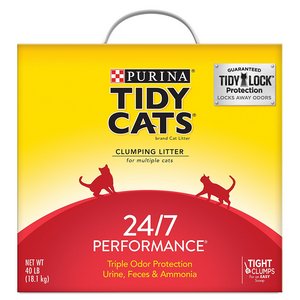
As its name suggests, this cat litter guarantees a fresh-smelling home 24 hours a day, seven days a week. It may have a subtle scent but it’s gentle enough for sensitive noses. Tidy Cats 24/7 clumps really well and there is less wastage. On the downside, you have to wait for the clumps to dry completely. Also, this litter is a little more expensive than its counterparts, but it may turn out economical with the less wastage.
- provides continuous odor-control
- prevents ammonia buildup
- suitable for high-traffic litter boxes
- low tracking
4. Arm & Hammer Clump & Seal Platinum
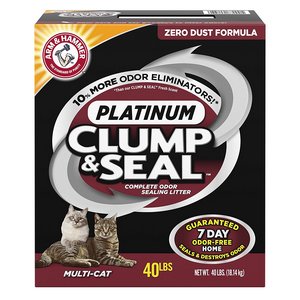
If you are looking for a cat litter with low costs and high performance, then look no further. As its name suggests, its formula uses Arm & Hammer’s far-famed baking soda to immediately snuff out foul odors on contact. What’s more, this product guarantees a 100% dust-free rate. But rather than big clumps, this litter forms small hard rocks. So not only is poop scooping a cinch, you won’t have to waste a lot of litter when you clean.
- no.1 in odor-control
- affordable and economical
- 100% dust-free formula
- forms small clumps
- has a subtle scent
- low tracking
5. World’s Best Cat Clumping Formula
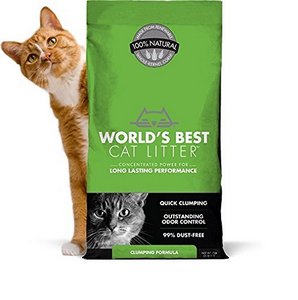
Just like product no. 4, World’s Best Cat Clumping Formula also creates small hard balls, which means it lasts a fairly long time. Also, this particular litter is eco-friendly just like other World’s Best products. And as such, it is biodegradable. You can flush the litter straight down the toilet! Our only gripe is that it somehow allows urine to flow into the base of the litter box. Thus, you have to fill the litter box with about four inches of litter to prevent it.
- 100% natural
- biodegradable (can be flushed)
- dust-free
- clumps fast
- forms small clumps
6. Arm & Hammer Double Duty Advance
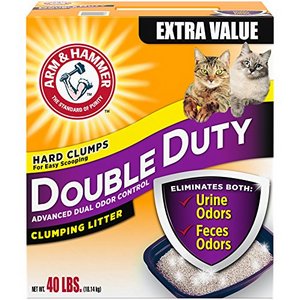
Every Arm & Hammer cat litter uses baking soda to eliminate pungent smells on contact. This particular litter, however, is slightly scented to help keep your home smelling good. Likewise, its strong clumping formula forms small rock-solid clumps so the litter stays put. This litter is also 99% dust-free, which is great news for our sensitive family members.
- fragrance-infused
- 99% dust-free
- low tracking
- exemplary odor control
7. Smart Cat All Natural
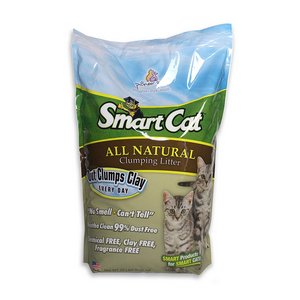
The Smart Cat All-Natural cat litter clumps so quick and hard that bad odors can hardly escape. The clumps will continue to harden until every drop of liquid is absorbed. Its formula has no artificial fragrance that could offend your cat’s sensitive nose. With hardly any dust, the Smart Cat Natural reduces respiratory problems in cats as well as ensures your home stays clean.
- clumps hard and fast
- no perfume added
- 99% dust-free
- low tracking
- biodegradable
8. BoxieCat Premium

Being on a tight budget doesn’t compromise quality, With the BoxieCat Premium, you can get an all-natural cat litter that is also 99.9% dust-free. This cat litter forms small hard clumps, which makes them a lot easier to catch with a shovel or a litter scoop. Although unscented, this product does a good job of preventing urine and fecal odors from lingering around your home.
- very affordable
- natural formula
- forms small clumps
- 99.9% dust-free
- low tracking
9. sWheat Scoop Natural
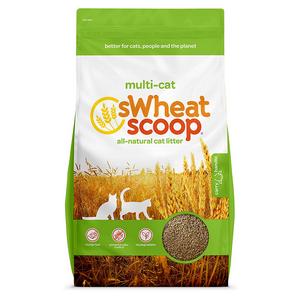
Unlike its counterparts, the sWheat Scoop Natural cat litter does not use sodium bentonite or quartz for its clumping effects. This litter actually uses 100% wheat instead. Nevertheless, its clumping effect is almost as fast and as firm as products that use sodium bentonite. That is why many veterinarians recommend this product. Its formulation also skipped out on perfumes, dyes, and chemicals of any kind.
- made with 100% wheat
- suitable for high-traffic litter boxes
- eco-friendly and 100% biodegradable
10. Blue Buffalo Naturally Fresh

The Naturally Fresh clumping cat litter from Blue Buffalo is another product that abstains from sodium bentonite. This litter owes its quick-clumping effects to its blend of walnut shells, an eco-friendly choice that blasts odors on contact. Aside from clay, this litter is also free of grains and chemicals. It is hypoallergenic and works virtually dust-free so you can breathe easier in your home.
- eco-friendly and biodegradable
- no chemicals added
- hypoallergenic and dust-free
- low tracking
Clumping Litter Questions
Is Clumping Litter Safe for Cats?
Speculations revolving around the safety of clumping litter is still rampant despite the statement from the American Society for the Prevention of Cruelty to Animals. According to their poison experts, clumping litter is generally safe.
Sodium bentonite or quartz silica only pose a minor gastrointestinal problem when ingested by some animals. It takes a large amount of ingested litter to cause a serious problem. Nevertheless, it is very unlikely for a cat to eat litter. This is actually more of a concern for your canine buddy than it is for your feline friend. Dogs sometimes raid the cat litter for fun or just to vex your cat.
While you don’t have to worry about your cat getting poisoned due to litter, there is a big chance that your kitten will die. Clumping cat litters aren’t recommended for kittens under four months of age as they will likely eat litter out of curiosity. Since their intestines are still tiny and underdeveloped, even just a small clump can cause intestinal blockage.
To avoid problems, wait until your kitten reaches five months old. He won’t likely taste cat litter to learn what it is by then since he’ll be able to distinguish edible foods.
When and How Do You Change a Clumping Cat Litter?
A dirty litter box is the feline equivalent of a filthy, unflushed toilet. So, make sure your cat’s litter box is clean itself. Scoop out kitty waste twice a day or as frequently as possible. Put the waste in a small plastic bag, tie it up, and throw it in the bin. You may also drop the clump straight into the toilet if it’s flushable.
In addition to daily poop scooping, you need to dump out the entire litter at least once a month or once every two weeks if possible. Then wash the litter box thoroughly using detergent and a tiny amount of bleach to eliminate harmful microorganisms. If you want to use a disinfectant spray, make sure it’s odorless. Wait for your cat’s litter box to dry completely before putting in fresh litter. Replace a plastic litter box at least once a year.
Is Baking Soda Safe for Cat Litter?
Our feline companions hate heavily-scented litters. Fortunately, you don’t need toxic chemicals to deodorize clean cat litter. Baking soda will do! Baking soda is an effective natural deodorizer. As a base, baking soda neutralizes urine, which is an acid. It eliminates odors by making urine more alkaline.
The best thing about baking soda is the fact that it doesn’t pose any harm to pets or children. Cat’s aren’t bothered by it at all. So, if your chosen clumping cat litter has baking soda, the better. Nonetheless, you may still add a layer of baking soda at the base of the litter box for an added punch.
Where do I Place My Cat’s Litter Box?
Many cat owners are guilty of placing the litter box in a hidden, murky area. Stop doing this! Doing so only makes cat smells concentrate. Keep your cat’s litter box in a well-ventilated area, particularly near a window so the odors are easily dispersed. Enough lighting and space are also imperative. Cats like to move in and out of the area comfortably. If he finds it unpleasant, chances are, your cat will bury his treasure in the center of your bedroom next time.